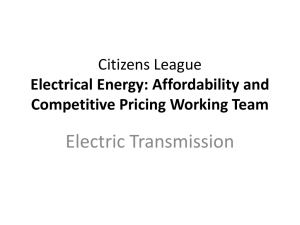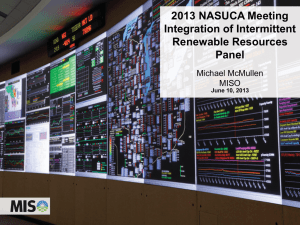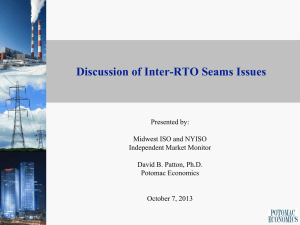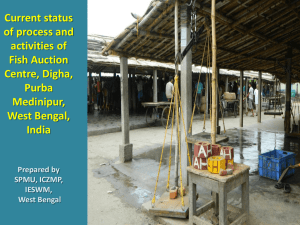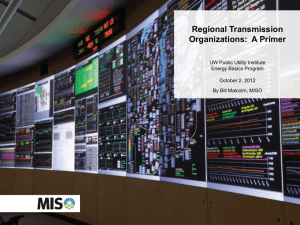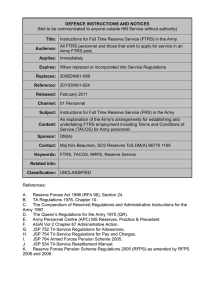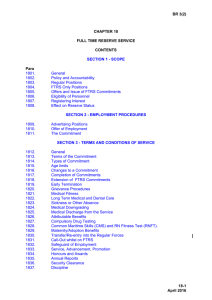RSC 10/6/10 MISO FTR Auctions Information Revised
advertisement
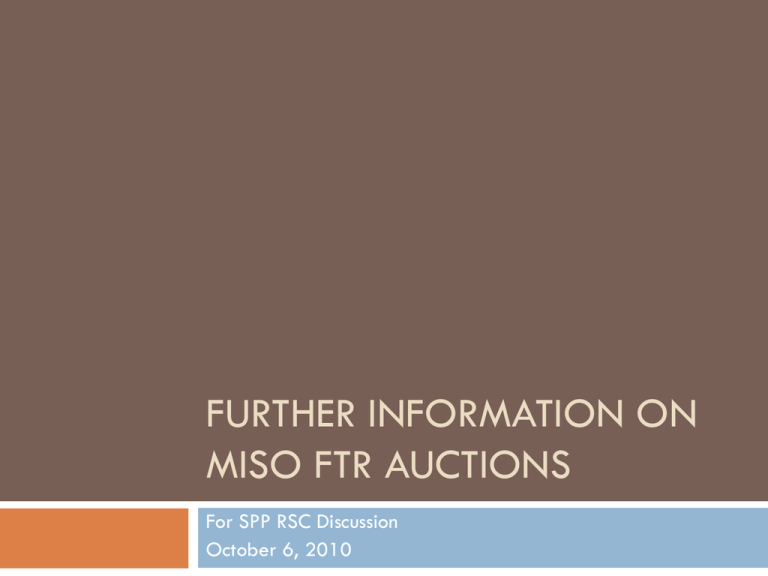
FURTHER INFORMATION ON MISO FTR AUCTIONS For SPP RSC Discussion October 6, 2010 2 Summary & Recommendations The Details follow this summary and the CAWG Recommendations MISO’s Monthly FTR Auction: Structure & Results 3 Summary of Findings 4 Financial participation in “Counterflow” FTRs offered into the MISO monthly FTR auction is beneficial to those wanting additional hedges. Profits are high ($47.5 M per year / $40.9 M per year applying 85.5% funding* of DA congestion payments), but includes risk premiums required to take on congestion cost risk. A portion of these transactions would not occur without buyers of Forward FTRs willing to pay the risk premiums to obtain hedges. “Counterflow” FTR paths include both lines that provide counterflow along with lines that do not provide counterflow and earn positive congestion payments from MISO. Financial participation in “forward” FTRs does earn a profit, but these profits are significantly reduced by less than full funding of FTRs by MISO. Applying the 85% funding* of DA congestion payments by MISO, total profits for “Forward” FTRs are only $1.6 Million with a rate of return of 1.10 %. Calculation of profits* for “non-hedging” customers gives a profit level of $8.5 Million per year with a rate of return of 7.49%. * Note: 85.5% is a rough approximation as it includes an average over all hours for both monthly and seasonal FTRs. “Counterflow” FTRs make up 89% of the total auction value and 75% of FTR MWs sold in MISO’s monthly auctions. 5 The annual average dollars paid to those providing “Counterflow” FTRs was $108 Million from the Auction. The annual average dollars paid by those requesting “Forward” FTRs to the Auction for hedging was $122 Million. Thus 89% = ($108/$122) of what those buying “Forward” FTRs paid to the Auction was then paid out from the auction to those providing “Counterflow” FTRs. In addition, MISO’s Independent Market Monitor calculates that From June of 2008 through May of 2009, “Counterflow” FTR MWs accounted for 93% of “Forward” FTRs; From June of 2009 through May of 2010, “Counterflow” FTR MWs accounted for 67% of “Forward” FTRs; and For the average of the two years, “Counterflow” FTR MWs accounted for 75% of “Forward” FTRs. Should transmission owners be concerned with profit taking by financial participants? 6 Using the 85.5% funding, annual profits from MISO’s monthly auction are $42.5 million, but these need to be divided between profits for “Counterflow” and “Forward” FTRs. Generally not for “Counterflow” FTRs ($40.9 million) Moreover, if transmission customers think the price is too high, they don’t have to buy the additional FTRs provided by offers of “Counterflow” FTRs from financial participants. There remains some concern about the positive congestion payments from MISO to these “Counterflow” FTRs. To some extent for “Forward” FTRs ($1.6 million). While these profits ($8.5 Million for non-hedging customers) are not significantly large compared to total congestion rents in MISO (in the range of $300 to $400 Million per year), they do exists, and should be tracked. Overall Recommendation 7 Assuming sufficient financial protections (as determined by the SPP credit standards task force and reviewed by the RSC) are put in place for nontransmission customers to participate in TCR auctions, the RSC should approve participation by any entity that meets the required financial protections. Recommendation for SPP 8 To eliminate confusion and to properly track profit taking, the SPP should calculate profit taking in the TCR auctions: Separately for “Forward” TCRs and “Counterflow” TCRs. Separately for Transmission Customers and nonTransmission Customers for “Forward” TCRs. 9 Details Presentation Format 10 This presentation uses a Question/Answer format to address the issue of profit-taking in MISO’s monthly auctions reported at the July SPP RSC meeting. The purpose is to gain a better understanding of the profit taking that occurred in the monthly FTR Auctions at MISO, and to gain a perspective of what this means for the proposed SPP TCR auctions. What new information was used to analyze profit taking in MISO? 11 Overview: The information covers the two-year period from June of 2008 through May 2010. This data is summarized on a per year basis. Individual market participant transaction data from the MISO FTR monthly auctions was made available. For each market participant two pieces of information were available: Auction Value – represents what the MP paid (or was paid) for an FTR. DA Value – represents what the MP would have received (or paid) in congestion rents for the FTR under full funding. The data was classified as: Positive Auction Value represents $ paid to a MP from the auction and was classified as payment for a counterflow FTR. Negative Auction Value represents $ paid by a MP to the auction and along with zero auction value transaction was classified as forward FTR purchases by the MP. Positive DA Value represent $ paid to the FTR holder by MISO. Negative DA Value represent $ paid by the FTR holder to MISO. How were profits calculated for each group? 12 “Counterflow” FTRs: Revenues = sum of Auction Value paid to individual participants + positive DA Value. Costs = sum of DA Value paid by same participants (negative DA Value). Forward FTRs: Revenues = sum of DA Value paid to individual participants (positive DA Value). Costs = sum of Auction value paid by same participants + negative DA Value. How do the calculations made here compare to those presented in MISO monthly reports? 13 MISO does not associate the revenues and costs with a market participant, but instead classifies: Negative Auction Value and positive DA Value (congestion payments) as revenues; and Positive Auction Value and negative DA Value as a cost. These calculations use the same classification of revenues and costs, but separates market participants between those paying the Auction (positive Auction Value) and those being paid by the Auction (negative Auction Value). Total revenues, costs, profits and rate of return are the same as for MISO’s calculations. Combined Results Revenues Costs Profits ROR 100% of DA Value $656.7 -$507.7 $149.0 29.35% 85.50% of DA Value $592.8 -$507.7 $85.1 16.76% How do Counterflow FTRs provide additional FTRs for those buying forward FTRs? 14 Net Flow = 500 MW 1000 MW A B 1000 MW 500 MW 500 MW 500 MW Rating The line rating is 500 MW from A to B. MPs want 1,000 MW of forward FTR from A to B, but only 500 MW is available. Financial MPs offer 500 MW of counterflow FTRs from B to A in the FTR Auction. If MPs wanting the Forward FTRs are willing to pay the offer price of those offering Counterflow FTRs, then MISO is able to expand sales of Forward FTRs by 500 MW. Without the counter position from financial participants, the additional 500 MWs of hedges against what MPs believe to be congestion costs would not be possible. These additional Forward FTRs would have been sold had MPs not been willing to pay the offer prices from financial participants offering Counterflow FTRs in the monthly auction, and the amount of hedging made available to transmission customers would have been significantly reduced. Example provided by Richard Dillon Why is the 89% of Auction Value from Counterflow FTRs significant? 15 In the example, if the congestion is from A to B, then the nodal price at B is higher than the nodal price at A. The Forward FTR holder is paid the difference between the price at B and the price at A. The Counterflow FTR holder must pay MISO the difference between the price at B and the price at A. This is why Forward FTRs purchased based on Counterflow FTRs are characterized as hedges against congestion purchased by transmission customers. A Counterflow FTR holder takes on the risk that the up-front payment received for taking on the potential payment to MISO of congestion costs. This is why Counterflow FTRs are characterized as being taken by financial participants. The 89% is significant because: Of the forward FTRs sold to transmission customers for hedging, 89% could not have taken place without participation by financial participants willing to take on the risk of having to pay MISO the additional congestion revenues. How does this division between forward and counterflow FTRs relate to profit-taking in the MISO monthly auctions? 16 Assuming full funding of FTRs by MISO, Annual profits from the MISO monthly auctions are $74.5 Million. Counterflow FTRs account for $47.5 Million. Forward FTRs account for $27 Million. Thus profits going to those providing counterflow account for 64% of total profits not adjusted for partial funding from MISO’s monthly auctions. Why is the 64% ($47.5 M) of Profits to Counterflow FTRs significant? 17 These profits represent market transaction willingly entered into from: Bids (what buyers were willing to pay) by transmission customers wanting to hedge congestion risk; and Offers (what sellers asked to be paid) by financial participants. Because they transfer funds from buyers to sellers within the MISO auction, they do not remove dollars from funds available to MISO to pay FTRs holders. Why are the profit levels for Counterflow FTRs so high? 18 Profit Calculations for Counterflow FTRs Counterflow FTR holders were paid $107.9 Million from the monthly MISO auctions, paid MISO $106 Million in congestion costs, and received $39 Million in congestion revenues (applying the 85.5% rule). Revenues = $107.9 + $39.0 = $146.9 Million Costs = $106 Million Profits = $146.9 - $106.0 = $40.9 Million ROR = $40.0 $106 = 38.6% The risk of costs that the Counterflow FTR holder takes on (payments of congestion costs to MISO) are high because of the volatility in the congestion costs they will pay MISO in the DA market. A high risk investment requires a large risk premium. If the profits are too large in relationship to the risk premium being asked by an individual financial participant, then another financial participant will make a lower offer. What is the rate of return from profits for Forward FTRs? 19 Profit Calculations for Monthly Auction Had MISO fully funded FTRs, Forward FTR holders would have received $148.5 Million in congestion payments from MISO’s DA market. In discussions with MISO, Richard Dillon determined that MISO only funded 85.5% of the DA Value of FTRs. Applying 85.5% to only positive congestion payments for Forward FTR holders, reduces congestion payments to $122.3 Million. Forward FTR holders paid the MISO monthly auction $123.1 Million. Applying 85.5% to congestion payments from MISO, profits go from $27 Million to just $1.6 Million. Dividing the profits by the costs paid to MISO in the auction plus congestion costs paid to MISO gives an average rate of return of 1.10 %. Does this mean that financial participants buying Forward FTRs only earn 1.10%? 20 No – for several reasons. The profits and costs calculated for Forward FTRs represent all (hedgers/transmission customers & investors/financial participants). We know that many hedgers paid a premium for Counterflow FTRs, and this means that the profits taken by those providing Counterflow FTRs represent corresponding “losses” for those paying the risk premium. Therefore, we expect the rate of return to be higher for financial participants than for hedgers. Classifying Forward FTRs by hedgers/transmission customers vs. nonhedgers/financial customers, the profits and rate of return are calculated For non-hedgers to be $8.5 M and 7.49%; For hedgers to be -$6.9 M and -20.2%, where this reflects the payment of the high risk premium for Counterflow FTRs.
